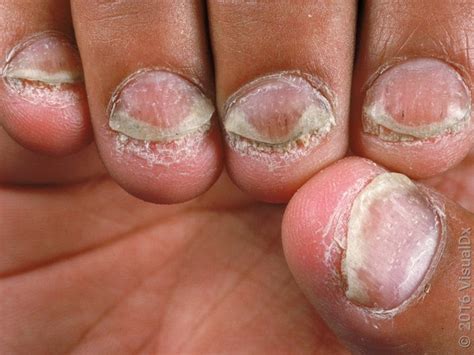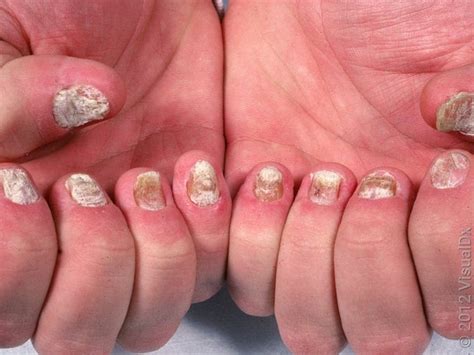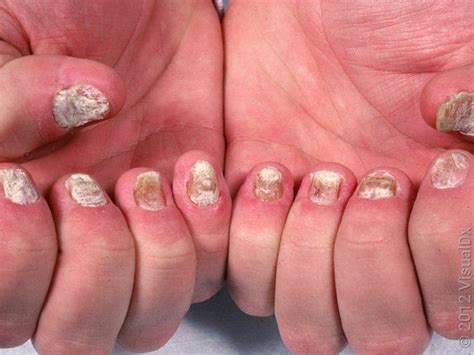Intro
Discover the 5 key psoriatic arthritis nail signs, including nail pitting, onycholysis, and nail thickening, to identify and manage this chronic condition, alleviating symptoms like joint pain and inflammation, and promoting overall well-being with proper diagnosis and treatment.
Psoriatic arthritis is a chronic condition that affects the joints, causing inflammation, pain, and stiffness. In addition to joint symptoms, psoriatic arthritis can also cause changes in the nails. Nail changes are a common symptom of psoriatic arthritis, occurring in up to 80% of people with the condition. These changes can be unsightly and uncomfortable, and in some cases, they can be a sign of underlying joint inflammation.
Nail changes in psoriatic arthritis can occur in various forms, including nail thickening, nail discoloration, and nail separation from the nail bed. In some cases, nail changes can be the first sign of psoriatic arthritis, even before joint symptoms appear. It's essential to recognize the different types of nail changes that can occur in psoriatic arthritis, as they can help diagnose and manage the condition.
The relationship between psoriatic arthritis and nail changes is complex, and researchers are still working to understand the underlying mechanisms. However, it's believed that the inflammation and immune system dysregulation that occur in psoriatic arthritis can affect the nail matrix, leading to changes in nail growth and appearance. By recognizing the different types of nail changes that can occur in psoriatic arthritis, people with the condition can work with their healthcare providers to develop effective treatment plans.
Introduction to Psoriatic Arthritis Nail Signs

Psoriatic arthritis nail signs can be a significant source of distress and discomfort for people with the condition. The nail changes can be painful, unsightly, and affect daily activities. However, by understanding the different types of nail changes that can occur, people with psoriatic arthritis can take steps to manage their symptoms and improve their quality of life.
Types of Psoriatic Arthritis Nail Signs
There are several types of nail changes that can occur in psoriatic arthritis, including: * Nail thickening: This is one of the most common types of nail changes in psoriatic arthritis. The nail becomes thickened and can be painful. * Nail discoloration: The nail can become discolored, turning yellow, brown, or gray. * Nail separation: The nail can separate from the nail bed, causing pain and discomfort. * Nail pitting: The nail can develop small pits or depressions, which can be a sign of underlying inflammation. * Nail crumbling: The nail can become brittle and crumbly, breaking off easily.Causes of Psoriatic Arthritis Nail Signs

The exact causes of psoriatic arthritis nail signs are not fully understood, but researchers believe that they are related to the underlying inflammation and immune system dysregulation that occur in the condition. The nail changes can be triggered by a combination of genetic and environmental factors, including:
- Genetic predisposition: People with a family history of psoriatic arthritis are more likely to develop nail changes.
- Inflammation: The inflammation that occurs in psoriatic arthritis can affect the nail matrix, leading to changes in nail growth and appearance.
- Immune system dysregulation: The immune system dysregulation that occurs in psoriatic arthritis can affect the nail, leading to changes in nail growth and appearance.
- Environmental factors: Environmental factors, such as trauma to the nail, can trigger nail changes in people with psoriatic arthritis.
Treatment Options for Psoriatic Arthritis Nail Signs
There are several treatment options available for psoriatic arthritis nail signs, including: * Topical treatments: Topical creams and ointments can be used to reduce inflammation and promote healthy nail growth. * Systemic treatments: Systemic medications, such as biologics, can be used to reduce inflammation and slow down disease progression. * Nail care: Good nail care practices, such as keeping the nails clean and dry, can help prevent nail changes. * Lifestyle modifications: Lifestyle modifications, such as avoiding trauma to the nail, can help prevent nail changes.Managing Psoriatic Arthritis Nail Signs

Managing psoriatic arthritis nail signs requires a comprehensive approach that includes medical treatment, lifestyle modifications, and good nail care practices. People with psoriatic arthritis can work with their healthcare providers to develop a treatment plan that addresses their specific needs and helps manage their symptoms.
Preventing Psoriatic Arthritis Nail Signs
While it's not possible to prevent psoriatic arthritis nail signs entirely, there are steps that people with the condition can take to reduce their risk of developing nail changes. These include: * Keeping the nails clean and dry * Avoiding trauma to the nail * Wearing protective gloves when engaging in activities that can cause nail trauma * Getting regular nail care * Managing stress and anxiety, which can trigger inflammation and worsen symptomsLiving with Psoriatic Arthritis Nail Signs

Living with psoriatic arthritis nail signs can be challenging, but there are many resources available to help people manage their symptoms and improve their quality of life. People with psoriatic arthritis can connect with others who have the condition through support groups and online communities, and can work with their healthcare providers to develop a treatment plan that addresses their specific needs.
Coping with Psoriatic Arthritis Nail Signs
Coping with psoriatic arthritis nail signs requires a combination of medical treatment, lifestyle modifications, and emotional support. People with the condition can work with their healthcare providers to develop a treatment plan that addresses their physical and emotional needs, and can connect with others who have the condition to share experiences and advice.Conclusion and Next Steps

In conclusion, psoriatic arthritis nail signs are a common symptom of psoriatic arthritis, and can be a significant source of distress and discomfort. By understanding the different types of nail changes that can occur, people with psoriatic arthritis can work with their healthcare providers to develop effective treatment plans and improve their quality of life. If you're experiencing psoriatic arthritis nail signs, don't hesitate to reach out to your healthcare provider for guidance and support.
Final Thoughts
Psoriatic arthritis nail signs are a manageable symptom of psoriatic arthritis, and with the right treatment and support, people with the condition can reduce their symptoms and improve their quality of life. By staying informed, connecting with others, and working with healthcare providers, people with psoriatic arthritis can take control of their condition and live fulfilling lives.What are the most common types of psoriatic arthritis nail signs?
+The most common types of psoriatic arthritis nail signs include nail thickening, nail discoloration, nail separation, nail pitting, and nail crumbling.
How can I prevent psoriatic arthritis nail signs?
+While it's not possible to prevent psoriatic arthritis nail signs entirely, you can reduce your risk by keeping your nails clean and dry, avoiding trauma to the nail, wearing protective gloves, and getting regular nail care.
What are the best treatment options for psoriatic arthritis nail signs?
+The best treatment options for psoriatic arthritis nail signs include topical treatments, systemic treatments, nail care, and lifestyle modifications. It's essential to work with your healthcare provider to develop a treatment plan that addresses your specific needs.
We hope this article has provided you with a comprehensive understanding of psoriatic arthritis nail signs. If you have any further questions or concerns, please don't hesitate to reach out to your healthcare provider. Share this article with others who may be experiencing similar symptoms, and let's work together to raise awareness and support for people with psoriatic arthritis.
